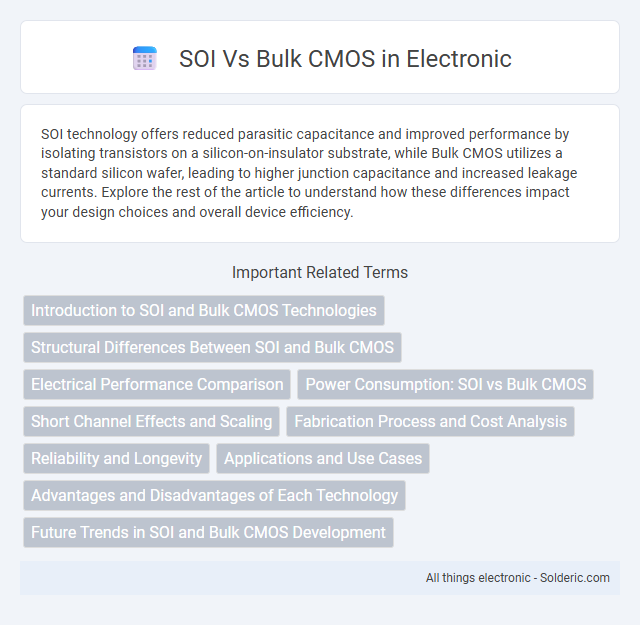SOI technology offers reduced parasitic capacitance and improved performance by isolating transistors on a silicon-on-insulator substrate, while Bulk CMOS utilizes a standard silicon wafer, leading to higher junction capacitance and increased leakage currents. Explore the rest of the article to understand how these differences impact your design choices and overall device efficiency.
Comparison Table
| Feature | SOI CMOS | Bulk CMOS |
|---|---|---|
| Substrate | Silicon-On-Insulator (SOI) wafer with buried oxide layer | Conventional silicon wafer |
| Parasitic Capacitance | Lower parasitic capacitance due to isolation oxide | Higher parasitic capacitance from junctions and substrate |
| Leakage Current | Reduced leakage current and improved power efficiency | Higher leakage current in off-state |
| Speed Performance | Higher switching speed and better performance at low voltage | Moderate switching speed |
| Manufacturing Cost | Higher due to complex wafer processing | Lower, widely used standard process |
| Radiation Hardness | Improved radiation tolerance | More susceptible to radiation-induced effects |
| Thermal Dissipation | Lower thermal conductivity due to buried oxide | Better heat dissipation |
| Device Isolation | Excellent isolation between devices | Less isolation, potential for latch-up |
Introduction to SOI and Bulk CMOS Technologies
SOI (Silicon-on-Insulator) technology uses a layered silicon-insulator-silicon substrate that reduces parasitic capacitance, enhancing speed and power efficiency compared to Bulk CMOS, which relies on a traditional silicon wafer. Bulk CMOS circuits are more mature and cost-effective but face limitations in scaling and leakage currents, making SOI advantageous for high-performance and low-power applications. Your design choice between SOI and Bulk CMOS impacts device performance, power consumption, and integration complexity.
Structural Differences Between SOI and Bulk CMOS
SOI CMOS features a thin silicon layer separated from the bulk substrate by a buried oxide layer, which reduces parasitic capacitance and improves performance. Bulk CMOS, on the other hand, is fabricated directly on the silicon wafer without an insulating layer, resulting in higher junction capacitance and increased leakage. The presence of the buried oxide in SOI allows for better isolation and reduced short-channel effects compared to the continuous silicon in bulk CMOS.
Electrical Performance Comparison
SOI (Silicon-On-Insulator) technology offers superior electrical performance compared to Bulk CMOS by reducing parasitic capacitance, which results in faster switching speeds and lower power consumption. The inherent isolation in SOI devices minimizes leakage currents and improves transistor threshold voltage stability, enhancing your circuit's reliability in high-frequency and low-power applications. Bulk CMOS, while more cost-effective, typically exhibits higher substrate noise and increased short-channel effects, which can limit overall device performance in advanced integrated circuits.
Power Consumption: SOI vs Bulk CMOS
SOI (Silicon-On-Insulator) technology significantly reduces power consumption compared to Bulk CMOS by minimizing parasitic capacitance through its insulating layer, leading to lower leakage currents and dynamic power dissipation. The thin buried oxide layer in SOI devices enhances switching speed and energy efficiency, making SOI particularly advantageous for low-power and high-performance applications. In contrast, Bulk CMOS structures suffer from higher junction capacitances and substrate leakage, resulting in increased power usage especially at smaller technology nodes.
Short Channel Effects and Scaling
SOI (Silicon-On-Insulator) technology significantly reduces short channel effects (SCEs) compared to Bulk CMOS by isolating the transistor channel with an insulating layer, which minimizes leakage currents and improves electrostatic control. In scaling, SOI devices demonstrate superior performance benefits with reduced parasitic capacitance and lower power consumption, enabling better scalability for advanced nodes below 10 nm. Bulk CMOS faces increased SCEs and leakage issues as channel lengths shrink, challenging its effectiveness in deep submicron technologies.
Fabrication Process and Cost Analysis
SOI (Silicon On Insulator) fabrication involves layering a thin silicon film atop an insulating oxide layer, which adds complexity and requires advanced wafer bonding or separation techniques, resulting in higher production costs compared to Bulk CMOS that uses a single silicon substrate. Bulk CMOS fabrication is a more established and cost-effective process, benefiting from simpler wafers and mature manufacturing infrastructure. Despite higher initial expenses, SOI offers performance advantages like reduced parasitic capacitance and improved speed, which can justify the cost in high-performance and low-power applications.
Reliability and Longevity
SOI (Silicon-On-Insulator) technology enhances reliability by reducing parasitic capacitance and minimizing latch-up risks, leading to improved device stability under high electric fields compared to Bulk CMOS. SOI's inherent isolation reduces leakage currents and susceptibility to soft errors from radiation, extending the longevity of semiconductor devices in harsh environments. Your choice of SOI can result in longer-lasting, more robust circuits, especially critical for aerospace, automotive, and medical applications.
Applications and Use Cases
SOI CMOS technology excels in high-performance and low-power applications such as RF circuits, aerospace, and automotive systems due to its reduced parasitic capacitance and improved radiation hardness. Bulk CMOS remains prevalent in general-purpose microprocessors, memory devices, and cost-sensitive consumer electronics because of its mature manufacturing process and lower production cost. SOI is preferred for specialized applications requiring enhanced speed, thermal management, and device isolation, while Bulk CMOS dominates large-scale integration in mainstream electronics.
Advantages and Disadvantages of Each Technology
SOI (Silicon on Insulator) technology offers advantages like reduced parasitic capacitance, improved speed, and lower power consumption due to the insulating layer, making it ideal for high-performance and low-power applications. However, SOI devices are more expensive to manufacture and have limited substrate options compared to Bulk CMOS, which is widely available, cost-effective, and well-understood but suffers from higher leakage currents and slower switching speeds. Bulk CMOS remains dominant in general-purpose electronics, while SOI is preferred for specialized high-frequency and radiation-hardened environments.
Future Trends in SOI and Bulk CMOS Development
Future trends in SOI (Silicon-On-Insulator) technology emphasize enhanced energy efficiency and reduced parasitic capacitance, driving advances in high-performance computing and RF applications. Bulk CMOS development is increasingly centered on scaling challenges, integrating advanced nodes with novel transistor architectures such as FinFETs and Gate-All-Around FETs to sustain Moore's Law. Both technologies are converging toward specialized use cases where SOI excels in low-power radios and bulk CMOS dominates mainstream logic circuits.
SOI vs Bulk CMOS Infographic

 solderic.com
solderic.com